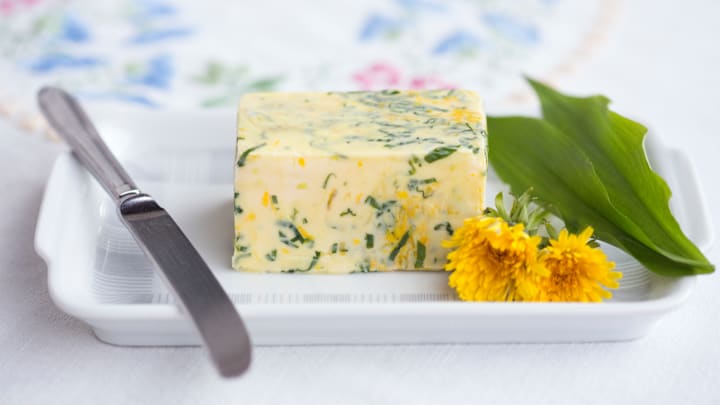What qualifies as a weed depends on your perspective. To some people, any uninvited plant that takes root in their yard is a nuisance that should be weeded out and tossed in the compost pile. Others look at wild flora growing near their home and see dinner.
Contrary to their reputation as worthless invaders, many common weeds are perfectly edible. In addition to being tasty and nutritious, plants like purslane, dandelion, and chickweed are free if you know how to identify them. Whenever harvesting weeds for consumption, make sure to stick to areas where you know the soil is healthy (like your home garden, for example) and avoid potentially polluted spots like sidewalks and parking lots. And never eat a plant unless you’re sure of what it is, as poisonous weeds often grow in the same places as the edible kind. Once you have the safety concerns covered, all you have to worry about is how to prepare these wild delicacies.
1. Dandelion

Of all the edible weeds on this list, this one may be the most likely to appear on restaurant menus. Though the leaves on a flowering dandelion can be bitter, they’re tangy and more palatable if harvested while the plant is still young. Dandelion greens are commonly chopped up and sprinkled into salads, but you can also eat the roots and yellow petals. When boiled and fermented, the flowers can be used to make wine.
2. Lamb’s Quarters
Lamb’s quarters can be identified by the toothed, blueish-green leaves growing from their stalks, which reach up to 6 feet tall. As a close relative of quinoa, the green is high in iron, protein, calcium, and B vitamins. Its nutty, bitter flavor makes it a perfect substitute for spinach.
3. Purslane
Also called pigweed, fatweed, and little hogweed, purslane is delicious and nutritious. The plant is rich in vitamin A, vitamin C, and omega-3 fatty acids, with thick, succulent-like leaves that are described as a cross between spinach and okra. The unique flavor and texture are welcome additions to an otherwise ordinary salad.
4. Bittercress

When your backyard garden is out of commission for the winter, go foraging for this cold-weather weed. Closely related to mustard greens, the teardrop leaves of this peppery plant can be added to salads or chopped into condiments. Look for it growing in the North Atlantic, Western, and Southern states.
5. Chickweed
Instead of plucking the tiny leaves off this plant, you’ll want to harvest the full stem to add to your salads. The leaves are tender like baby spinach with a taste similar to parsley and corn silk. They grow in thick, sprawling patches, so you should have no trouble harvesting enough for a whole meal in one outing.
6. Stinging Nettle
This edible weed requires a bit of prep work before it’s ready for your dinner table. To remove the stinging hairs (which contain the same toxins as fire ants), blanch the toothed leaves in salted water and follow that up with a dip in an ice bath. Once that's done, stinging nettles are fit to add to soup, pasta, or any cooked dish that calls for spinach.
7. Wild Violet

On top of being pretty, the flowers and leaves of the wild violet are totally safe to eat. Try tossing them into salads, or use the purple petals as a colorful garnish in desserts.
8. Japanese Honeysuckle

Many foragers got their start sucking the sweet nectar out of honeysuckle blossoms as children. For a more mature way to consume this invasive weed, try fermenting the flowers with sugar, water, and lemon juice in a glass jar. After several days, you'll have a bubbly, sweet beverage. Just remember to stick to the flowers when foraging, as honeysuckle berries are poisonous.
9. Sheep sorrel
French sorrel is a delicacy, and you can find its humble cousin growing in the wild. Like the domestic version of the plant, sheep sorrel leaves are prized for their lemony flavor. The weeds are slightly bitter tasting, and they should be used with other greens as an ingredient in salads.
10. Wild Garlic

Patches of long, blade-like leaves are often connected to wild garlic bulbs growing underground. The bulbs can be chopped up and used in place of regular garlic, while the leaves make a great ingredient in pesto. Just make sure to use your nose while foraging for them. Wild garlic is sometimes mistaken for the highly toxic lily of the valley, and the pungent, garlicky smell is what sets it apart.
11. Thistle

Thistle’s spiny leaves make it difficult to harvest in the wild, but brave foragers will be rewarded. When stripped of their leaves, thistle's celery-like stems can be chopped up and used in soups, salads, and stir-fries.
A version of this story originally ran in 2021; it has been updated for 2023.
